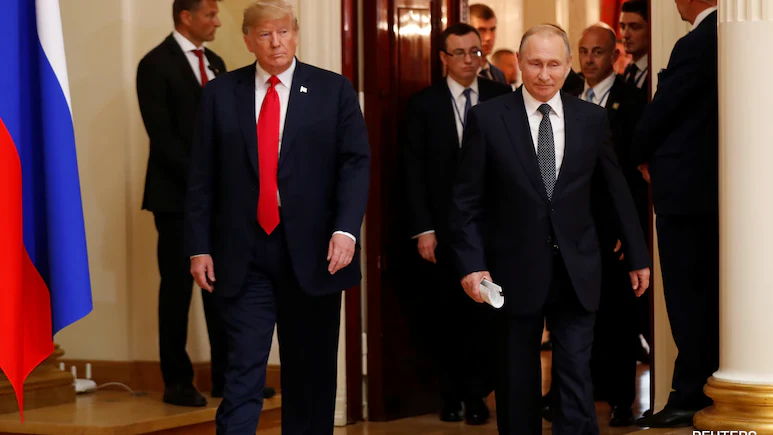An Overview of the Historic Meeting in Alaska
In a highly anticipated summit, US President Donald Trump and Russian President Vladimir Putin are set to meet at a US air base in Alaska this coming Friday. This marks the first face-to-face encounter between sitting presidents of the two nations in over four years. The talks will focus primarily on the ongoing conflict in Ukraine, which has escalated significantly since Russia’s invasion in February 2022. As tensions continue to rise, expectations are running high regarding the outcome of this pivotal meeting.
The summit holds added significance as it will be Putin’s first visit to a Western country since the war began, and his first visit to the United States in a decade. Both leaders come into this meeting with their respective agendas, and the clash of ideologies will be crucial in determining the future of not just Ukraine, but of global geopolitics.
The meeting comes at a time when both Russia and Ukraine remain steadfast in their positions, making the prospect of diplomatic breakthroughs appear tenuous at best. With so much at stake, the world watches closely as Trump and Putin engage in what could be a transformative conversation.
Understanding Russia’s Position
For President Putin, this summit is a chance to reinforce Russia’s demands and assert its position on the global stage after years of increasing isolation. In a draft peace plan circulated in June, Russia outlined its primary demands for ending the war, including the withdrawal of Ukrainian forces from territories such as Kherson, Lugansk, Zaporizhzhia, and Donetsk. These regions were claimed by Russia during its 2022 annexation, a move that Ukraine vehemently denies.
Russia is also advocating for Ukraine to terminate its military mobilization efforts and abandon any aspirations to join NATO. Additionally, the Russian government is pressing Western nations to cease their military aid to Ukraine—a request which many view as tantamount to capitulation. Furthermore, Russia seeks assurances regarding the rights and freedoms of the Russian-speaking populace in Ukraine and aims to prohibit what it characterizes as the “glorification of Nazism,” a claim that Ukraine dismisses as ludicrous.
In a pivotal aspect of their negotiations, Russia demands the lifting of all Western sanctions that have been imposed in response to its aggressive actions. These sanctions have significantly impacted the Russian economy and are a major point of contention.
Ukraine’s Stance and Conditions for Peace
Although Ukrainian President Volodymyr Zelensky is not physically attending the summit, he has made his position clear: any peace deal that excludes Ukraine is untenable. For Zelensky, the prospect of a summit without Ukrainian representation feels like a “personal victory” for Putin, signaling that Ukraine’s sovereignty and agency could be compromised in the negotiations.
Ukraine is demanding a comprehensive ceasefire as a prerequisite for any peace talks. This includes an unconditional halt to hostilities across land, sea, and air. The Ukrainian government has also called for the unconditional release of all prisoners of war and the return of Ukrainian children whom they allege have been kidnapped by Russian forces.
According to Ukraine, thousands of children have been forcibly transferred to Russian territories and enrolled in Russian families, an allegation that Russia disputes, although it acknowledges that many children are located within its borders. Ukraine maintains that any prospective peace agreement must include robust security guarantees to prevent future Russian aggression. Additionally, Ukraine insists that the lifting of sanctions against Russia must be gradual and contingent upon compliance with the agreement.
The United States’ Expectations and Strategies
For President Trump, this summit represents a critical opportunity to showcase his diplomatic skills and potentially secure a pivotal deal. Trump has previously asserted that he could end the war within “24 hours” of taking office, but as the conflict drags on, his administration has faced mounting pressure to deliver results. Despite numerous calls and credentials from U.S. envoys, tangible progress has proven elusive.
The summit is seen as Trump’s first real chance to negotiate face-to-face with Putin and push for a resolution. Trump has warned of “very severe consequences” for Russia should it fail to halt its offensive actions in Ukraine. Yet, the White House has tempered expectations, describing the summit primarily as a “listening exercise” for the President.
Initially, Trump hinted at the possibility of some “land swapping” during the negotiations, though he quickly appeared to backtrack after consultations with European leaders. The U.S. administration has expressed that it would like to see a ceasefire implemented “very, very quickly.” If this first summit proves successful, Trump suggested that Zelensky could potentially join future discussions, further integrating Ukraine into the peace process.
The European Perspective and Exclusion from the Talks
Despite their significant military support for Ukraine and the hosting of millions of Ukrainian refugees, European leaders have once again found themselves sidelined in negotiations that could fundamentally reshape regional security architecture. Notably, European representatives were excluded from previous meetings between Russian and Ukrainian officials, as well as from Russia-U.S. talks.
The leaders of Britain, France, Italy, Germany, Poland, Finland, and the EU Commission recently issued a joint statement emphasizing the necessity of Ukraine’s involvement in any meaningful peace talks. French President Emmanuel Macron articulated the sentiment that “territorial questions concerning Ukraine can be, and will be, negotiated only by the Ukrainian president.” Both Macron and UK Prime Minister Keir Starmer have signaled a readiness to deploy peacekeepers in Ukraine following the cessation of hostilities, though this idea has been rejected by Russia.
As the summit approaches, the dynamics of the discussions remain uncertain, and the world watches to see how both leaders will navigate these complex geopolitical issues.
For continuous coverage of the Ukraine conflict and international relations, stay updated with[NDTV](https://www.ndtv.com) and related content on[The New York Times](https://www.nytimes.com) and the[BBC](https://www.bbc.com).
DISCLAIMER
We have taken every measure to ensure that the information in this article and on our social media platforms is accurate, verified, and obtained from reliable sources. For feedback or complaints, please contact us at info@hamslive.com.


